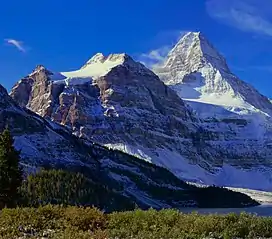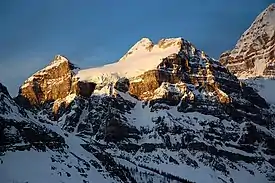| Mount Magog | |
|---|---|
 Mt. Magog (left) and Mt. Assiniboine (right) | |
| Highest point | |
| Elevation | 3,095 m (10,154 ft)[1][2] |
| Prominence | 188 m (617 ft)[3] |
| Parent peak | Mount Assiniboine (3616 m)[3] |
| Listing | |
| Coordinates | 50°52′45″N 115°38′05″W / 50.87917°N 115.63472°W[4][5] |
| Geography | |
 Mount Magog Location in Alberta and British Columbia  Mount Magog Mount Magog (British Columbia) | |
| Country | Canada |
| Provinces | Alberta and British Columbia |
| Parks | |
| Parent range | Park Ranges[3] |
| Topo map | NTS 82J13 Mount Assiniboine[4] |
| Climbing | |
| First ascent | 1920 A.J. Gilmour, A.H. MacCarthy, A.W. Wakefield, F.N. Waterman[1][3] |

Mount Magog
Mount Magog is located on the border of Alberta and British Columbia on the Continental Divide in the Canadian Rockies. It also straddles the shared boundary of Banff National Park with Mount Assiniboine Provincial Park. It was named in 1930 after references in the Bible.[1][3]
Geology
Mount Magog is composed of sedimentary rock laid down from the Precambrian to Jurassic periods.[6] Formed in shallow seas, this sedimentary rock was pushed east and over the top of younger rock during the Laramide orogeny.[7]
Climate
Based on the Köppen climate classification, Mount Magog is located in a subarctic climate with cold, snowy winters, and mild summers.[8] Temperatures can drop below -20°C with wind chill factors below -30°C.
Gallery
.jpeg.webp) Magog Lake sunrise, Mt. Magog to left
Magog Lake sunrise, Mt. Magog to left
See also
References
- 1 2 3 "Mount Magog". cdnrockiesdatabases.ca. Retrieved 2019-09-14.
- ↑ "Topographic map of Mount Magog". opentopomap.org. Retrieved 2021-10-11.
- 1 2 3 4 5 "Mount Magog". Bivouac.com. Retrieved 2019-09-14.
- 1 2 "Mount Magog (BC)". Geographical Names Data Base. Natural Resources Canada. Retrieved 2019-09-14.
- ↑ "Mount Magog". BC Geographical Names. Retrieved 2019-09-14.
- ↑ Belyea, Helen R. (1960). The Story of the Mountains in Banff National Park (PDF). parkscanadahistory.com (Report). Ottawa: Geological Survey of Canada. Archived (PDF) from the original on 2015-10-02. Retrieved 2019-09-13.
- ↑ Gadd, Ben (2008). Geology of the Rocky Mountains and Columbias.
- ↑ Peel, M. C.; Finlayson, B. L.; McMahon, T. A. (2007). "Updated world map of the Köppen−Geiger climate classification". Hydrol. Earth Syst. Sci. 11: 1633–1644. ISSN 1027-5606.
This article is issued from Wikipedia. The text is licensed under Creative Commons - Attribution - Sharealike. Additional terms may apply for the media files.